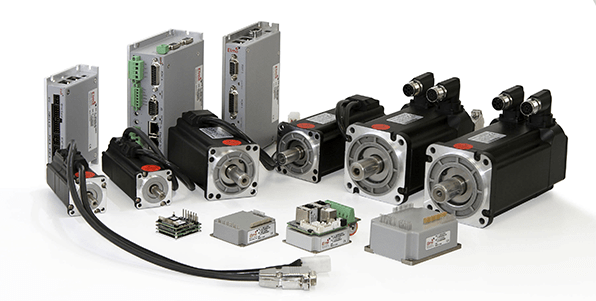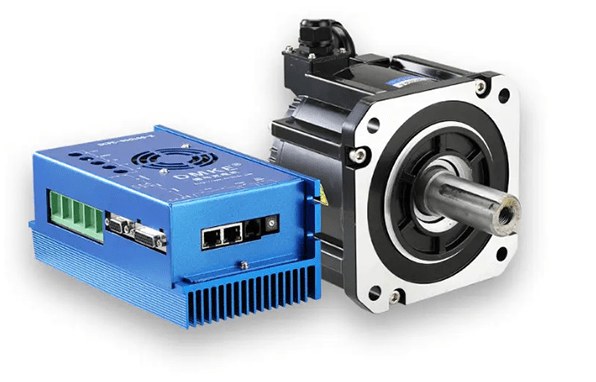Video: DC Servo Motor: Working Principle, Pros &Cons, Speed Adjustment Methods and Application

Figure 1: Servo motors and related components.
1. Working Principle of DC Servo Motor
DC servo motor consists of C power supply, motor, encoder and controller. When a motor is connected to DC power, it creates a magnetic field in the motor.
Next, the controller applies a control signal to the armature. This signal can be a pulse width modulation (PWM) signal, whose frequency is generally between a few kilohertz and tens of kilohertz. When the control signal changes, it will cause a change in the magnetic field inside the motor, so that the motor will rotate.
The encoder is used to detect the angle and position of the motor. By feeding the encoder signal back to the controller, the controller can control the rotation speed and direction of the motor in real time. The controller calculates the output value of the control signal by comparing the encoder's feedback signal with the expected signal, and transmits the output signal to the motor.

Figure 2: Servo motor working principle diagram.
2. Types of DC Servo Motors
Brushed DC Servo Motors: This type of motor uses brushes to connect power to a rotating armature to produce rotational torque. They are generally simple and low-cost, but brush wear and friction can affect life and performance.
Brushless DC Servo Motors: Brushless motors use electronic control to drive the armature, eliminating the brushes in traditional DC motors. They generally have higher efficiency, require less maintenance, and have a longer lifespan, but are more expensive to manufacture.

Figure 3: Brushless DC servo motor.
3. Pros & Cons of DC Servo System
As a traditional servo system, the DC servo system still has certain advantages in terms of control accuracy, dynamic response, and reliability. However, it also has some disadvantages. The advantages and disadvantages of DC servo systems will be discussed below.
3.1 Advantages of DC Servo System
1. High control accuracy
The DC servo system can be controlled through the PID algorithm and has high control accuracy. In the field of industrial automation, its control accuracy can reach 0.01%.
2. Fast dynamic response
The DC servo system has fast dynamic response characteristics, and the response time is generally around 10-50 milliseconds. This allows it to adapt to high-speed motion scenarios and meet the precise control requirements of high-speed motion.
3. Good stability
The DC servo system controls the system by controlling the current of the motor. Therefore, the DC servo system has high control stability and can achieve precise control under high load conditions.
3.2 Disadvantages of DC Servo Systems
1. Limited speed regulation accuracy
Although DC servo motors have many advantages over other motor types in speed control systems, their speed control accuracy is subject to some limitations. Moreover, when running at high speed, the motor will also face the influence of inertia and load, resulting in a decrease in speed regulation accuracy.
2. Short lifespan
When DC servo motors operate at high intensity for a long time, they are prone to problems such as brush wear and aging of electronic components, resulting in a short service life.
3. High maintenance costs
DC servo motors require regular replacement of brushes, encoders and other additional equipment, and due to their complex control circuits, repair costs are high if they malfunction.
4. Electromagnetic interference problem
DC servo motors will produce electromagnetic interference when running at high speed, affecting the normal operation of surrounding electronic equipment.

Figure 4: DC servo motor.
4. DC Servo Motor Speed Adjustment Methods
There are many ways to adjust the speed of DC servo motors. The following are some of the commonly used methods:
Voltage modulation method: Adjust the motor speed by changing the output voltage of the DC power supply. This method is simple and easy, but the speed adjustment range is limited.
Pulse width modulation method: Change the speed of the motor by changing the duty cycle of the PWM wave. This method can achieve a wide range of speed regulation, but it requires the use of high-frequency PWM signals, so it has higher requirements for the controller.
Current modulation method: Change the speed of the motor by changing the current of the DC motor. This method can achieve a larger speed regulation range, but it needs to be adjusted according to the characteristic curve of the motor and has higher requirements for the controller.
PI control method: Through feedback control of the motor's speed, proportional and integral control algorithms are used to adjust the motor's control signal so that the motor's output speed can be as close as possible to the desired speed. This method can achieve higher control accuracy and stability.
Fuzzy control method: By establishing a fuzzy control model of the motor and using a fuzzy logic control algorithm to adjust the control signal of the motor, the output speed of the motor can be as close as possible to the desired speed. This method can deal with some complex nonlinear control problems.
It is necessary to select the appropriate speed regulation method according to the actual application requirements and motor characteristics, and adjust the controller parameters according to the specific situation.

Figure 5: DC motor fuzzy control system structure diagram.
5. DC Servo Motor Application Fields
DC servo motor application areas include:
1. Industrial automation: DC servo motors are often used in the field of industrial automation, such as conveyor belts, robotic arms, automated assembly systems on production lines, etc. They provide high precision and controllability and are suitable for applications requiring fast response and high-precision positioning.
2. Machine tools and CNC machinery: DC servo motors are widely used in CNC machine tools, milling machines, drilling machines, laser cutting machines and other equipment to provide precise position control and speed adjustment.
3. Robotics: DC servo motors play a key role in industrial robots, collaborative robots, and service robots, and are used for various precision tasks such as pick and place, welding, spraying, etc.
4. Medical equipment: DC servo motors are used in medical equipment, such as CT scanners, surgical robots, and medical instruments to ensure high-precision movement and control.
5. Aerospace: DC servo motors are also widely used in the aerospace field, such as navigation systems, aircraft control systems and satellite equipment.
6. Laboratory equipment: DC servo motors are often used in various equipment in scientific laboratories, such as microscopes, experimental tables, sample rotators, etc., to achieve precise control and movement.



